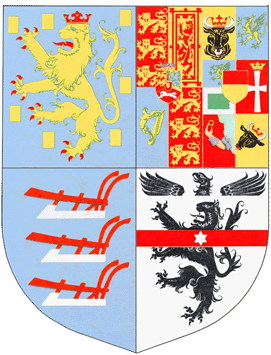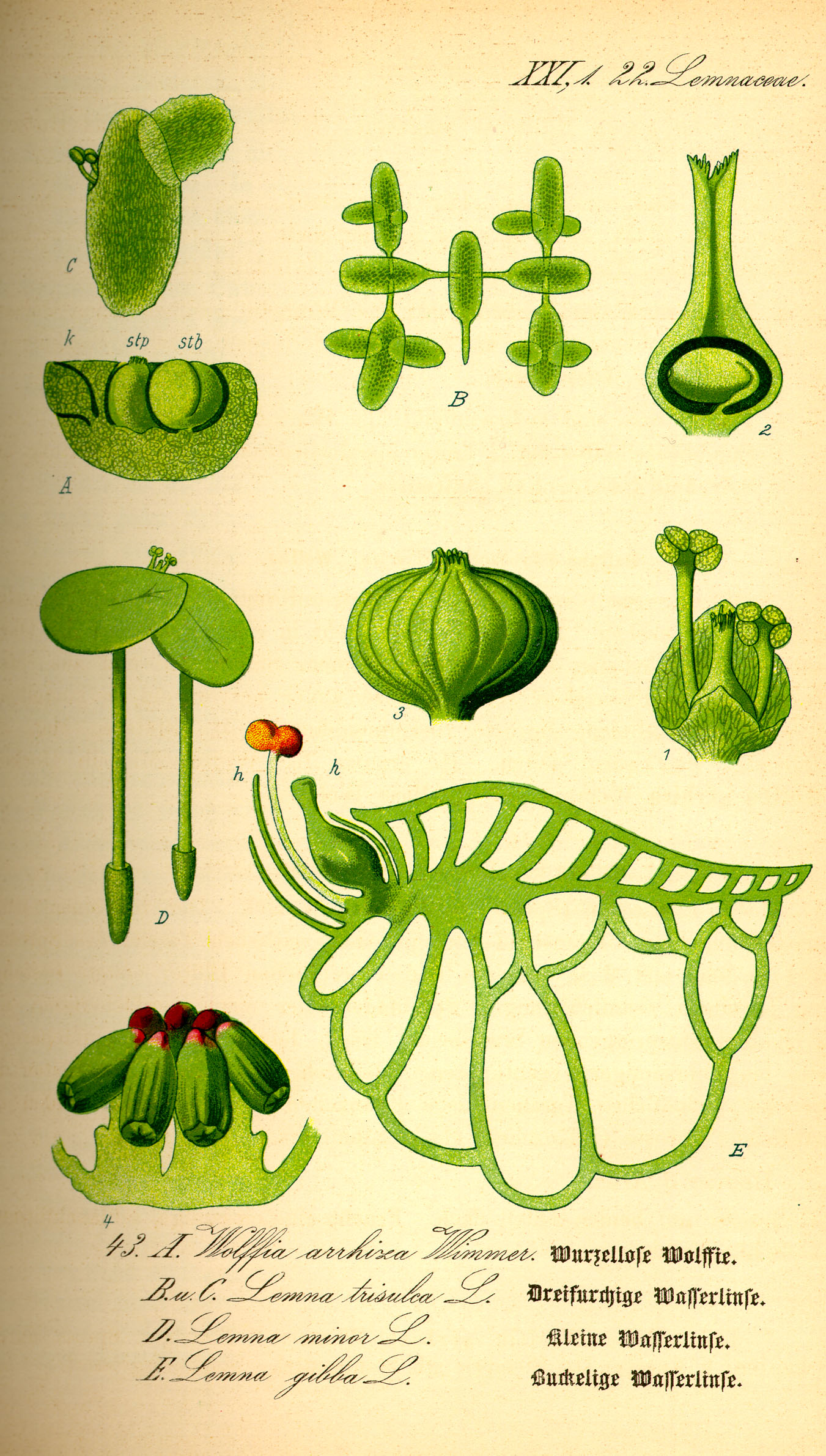|
Wolffia Neglecta
''Wolffia'' is a genus of aquatic plants with a cosmopolitan distribution. They include the smallest flowering plants on Earth. Commonly called watermeal or duckweed, these aquatic plants resemble specks of cornmeal floating on the water. Individuals often float together in pairs or form floating mats with related plants, such as ''Lemna'' and ''Spirodela'' species. Description ''Wolffia'' are free-floating aquatic plants with fronds that are nearly spherical to cylindrical in shape and lack airspaces or veins. They do not have roots. Their rarely seen flowers originate from a cavity on the upper surface of the frond, and each flower has one stamen and one pistil. Although ''Wolffia'' can reproduce by seed, they usually use vegetative reproduction. A mother frond has a terminal conical cavity from which it produces daughter fronds. Physiology The growth rate of ''Wolffia'' varies within and among species. The rates of photosynthesis and respiration also vary proportionately ... [...More Info...] [...Related Items...] OR: [Wikipedia] [Google] [Baidu] |
Matthias Jakob Schleiden
Matthias Jakob Schleiden (; 5 April 1804 – 23 June 1881) was a German botanist and co-founder of cell theory, along with Theodor Schwann and Rudolf Virchow. Career Matthias Jakob Schleiden was born in Hamburg. on 5 April 1804. His father was the municipal physician of Hamburg. Schleiden pursued legal studies graduating in 1827. He then established a legal practice but after a period of emotional depression and attempted suicide, he changed professions. He studied natural science at the University of Göttingen in Göttingen, Germany, but transferred to the University of Berlin in 1835 to study plants. Johann Horkel, Schleiden's uncle, encouraged him to study plant embryology. He soon developed his love for botany and cats into a full-time pursuit. Schleiden preferred to study plant structure under the microscope. As a professor of botany at the University of Jena, he wrote ''Contributions to our Knowledge of Phytogenesis'' (1838), in which he stated that all plants are ... [...More Info...] [...Related Items...] OR: [Wikipedia] [Google] [Baidu] |
Wolffia Angusta
''Wolffia angusta'' is a species of flowering plant in the family Araceae. It has been listed by the Guinness Book of World Records as the smallest flowering plant on record, measuring in length and in width. However, more recently ''Wolffia globosa ''Wolffia globosa'' is a species of flowering plant known by the common names Asian watermeal and duckweed. It is native to Asia and is found in parts of the Americas and Africa, where it is an introduced species. It grows in mats on the surface ...'' has been described as the smallest, at in diameter. References Lemnoideae Plants described in 1980 {{Araceae-stub ... [...More Info...] [...Related Items...] OR: [Wikipedia] [Google] [Baidu] |
Lemnoideae
Lemnoideae is a subfamily of flowering aquatic plants, known as duckweeds, water lentils, or water lenses. They float on or just beneath the surface of still or slow-moving bodies of fresh water and wetlands. Also known as bayroot, they arose from within the arum or aroid family (Araceae), so often are classified as the subfamily Lemnoideae within the family Araceae. Other classifications, particularly those created prior to the end of the twentieth century, place them as a separate family, Lemnaceae. These plants have a simple structure, lacking an obvious stem or leaves. The greater part of each plant is a small organized "thallus" or "frond" structure only a few cells thick, often with air pockets (aerenchyma) that allow it to float on or just under the water surface. Depending on the species, each plant may have no root or may have one or more simple rootlets. Reproduction is mostly by asexual budding (vegetative reproduction), which occurs from a meristem enclosed at the b ... [...More Info...] [...Related Items...] OR: [Wikipedia] [Google] [Baidu] |
Palomar College
Palomar College is a public community college in San Diego County, California. The main campus is in San Marcos and three centers and four education sites are located elsewhere throughout north San Diego County. The largest of these by student population is the education center located in Escondido. In 2018, education centers in Rancho Bernardo and Fallbrook opened. The Rancho Bernardo Education Center is located on 27 acres at 11111 Rancho Bernardo Road, and the Fallbrook Education Center is located on 81 acres at 35090 Horse Ranch Creek Road. Other education sites are located at Camp Pendleton and at Ramona High School. Academics Palomar College offers 250 associate's degrees and certificate programs, and also offers programs for students wishing to transfer to many different four-year universities, including institutions in the University of California and California State University systems. These programs are organized into five academic divisions: *Arts, Media, Busines ... [...More Info...] [...Related Items...] OR: [Wikipedia] [Google] [Baidu] |
Rutgers University
Rutgers University (; RU), officially Rutgers, The State University of New Jersey, is a Public university, public land-grant research university consisting of four campuses in New Jersey. Chartered in 1766, Rutgers was originally called Queen's College, and was affiliated with the Reformed Church in America, Dutch Reformed Church. It is the eighth-oldest college in the United States, the second-oldest in New Jersey (after Princeton University), and one of the nine U.S. colonial colleges that were chartered before the American Revolution.Stoeckel, Althea"Presidents, professors, and politics: the colonial colleges and the American revolution", ''Conspectus of History'' (1976) 1(3):45–56. In 1825, Queen's College was renamed Rutgers College in honor of Colonel Henry Rutgers, whose substantial gift to the school had stabilized its finances during a period of uncertainty. For most of its existence, Rutgers was a Private university, private liberal arts college but it has evolved int ... [...More Info...] [...Related Items...] OR: [Wikipedia] [Google] [Baidu] |
Wolffia Neglecta
''Wolffia'' is a genus of aquatic plants with a cosmopolitan distribution. They include the smallest flowering plants on Earth. Commonly called watermeal or duckweed, these aquatic plants resemble specks of cornmeal floating on the water. Individuals often float together in pairs or form floating mats with related plants, such as ''Lemna'' and ''Spirodela'' species. Description ''Wolffia'' are free-floating aquatic plants with fronds that are nearly spherical to cylindrical in shape and lack airspaces or veins. They do not have roots. Their rarely seen flowers originate from a cavity on the upper surface of the frond, and each flower has one stamen and one pistil. Although ''Wolffia'' can reproduce by seed, they usually use vegetative reproduction. A mother frond has a terminal conical cavity from which it produces daughter fronds. Physiology The growth rate of ''Wolffia'' varies within and among species. The rates of photosynthesis and respiration also vary proportionately ... [...More Info...] [...Related Items...] OR: [Wikipedia] [Google] [Baidu] |
Wolffia Microscopica
''Wolffia'' is a genus of aquatic plants with a cosmopolitan distribution. They include the smallest flowering plants on Earth. Commonly called watermeal or duckweed, these aquatic plants resemble specks of cornmeal floating on the water. Individuals often float together in pairs or form floating mats with related plants, such as ''Lemna'' and ''Spirodela'' species. Description ''Wolffia'' are free-floating aquatic plants with fronds that are nearly spherical to cylindrical in shape and lack airspaces or veins. They do not have roots. Their rarely seen flowers originate from a cavity on the upper surface of the frond, and each flower has one stamen and one pistil. Although ''Wolffia'' can reproduce by seed, they usually use vegetative reproduction. A mother frond has a terminal conical cavity from which it produces daughter fronds. Physiology The growth rate of ''Wolffia'' varies within and among species. The rates of photosynthesis and respiration also vary proportionately ... [...More Info...] [...Related Items...] OR: [Wikipedia] [Google] [Baidu] |
Wolffia Globosa
''Wolffia globosa'' is a species of flowering plant known by the common names Asian watermeal and duckweed. It is native to Asia and is found in parts of the Americas and Africa, where it is an introduced species. It grows in mats on the surface of calm, freshwater bodies, such as ponds, lakes, and marshes. It is a very tiny, oval-shaped plant with no leaves, stems, or roots. The body of the plant, a transparent green frond, is less than a millimeter wide. In one human experiment, processed ''W. globosa'' was reported to provide dietary protein and vitamin B12. ''Wolffia globosa'' has been described as the world's smallest flowering plant, at in diameter. Known in Thai as ''Pham'' (ผํา), it is a popular item in Thai cuisine, especially in Isan Northeast Thailand or Isan (Isan/ th, อีสาน, ; lo, ອີສານ; also written as Isaan, Isarn, Issarn, Issan, Esan, or Esarn; from Pali ''īsānna'' or Sanskrit ईशान्य ''īśānya'' "northeast") cons ... [...More Info...] [...Related Items...] OR: [Wikipedia] [Google] [Baidu] |
Wolffia Elongata
''Wolffia'' is a genus of aquatic plants with a cosmopolitan distribution. They include the smallest flowering plants on Earth. Commonly called watermeal or duckweed, these aquatic plants resemble specks of cornmeal floating on the water. Individuals often float together in pairs or form floating mats with related plants, such as ''Lemna'' and ''Spirodela'' species. Description ''Wolffia'' are free-floating aquatic plants with fronds that are nearly spherical to cylindrical in shape and lack airspaces or veins. They do not have roots. Their rarely seen flowers originate from a cavity on the upper surface of the frond, and each flower has one stamen and one pistil. Although ''Wolffia'' can reproduce by seed, they usually use vegetative reproduction. A mother frond has a terminal conical cavity from which it produces daughter fronds. Physiology The growth rate of ''Wolffia'' varies within and among species. The rates of photosynthesis and respiration also vary proportionately ... [...More Info...] [...Related Items...] OR: [Wikipedia] [Google] [Baidu] |
Wolffia Cylindracea
''Wolffia'' is a genus of aquatic plants with a cosmopolitan distribution. They include the smallest flowering plants on Earth. Commonly called watermeal or duckweed, these aquatic plants resemble specks of cornmeal floating on the water. Individuals often float together in pairs or form floating mats with related plants, such as ''Lemna'' and ''Spirodela'' species. Description ''Wolffia'' are free-floating aquatic plants with fronds that are nearly spherical to cylindrical in shape and lack airspaces or veins. They do not have roots. Their rarely seen flowers originate from a cavity on the upper surface of the frond, and each flower has one stamen and one pistil. Although ''Wolffia'' can reproduce by seed, they usually use vegetative reproduction. A mother frond has a terminal conical cavity from which it produces daughter fronds. Physiology The growth rate of ''Wolffia'' varies within and among species. The rates of photosynthesis and respiration also vary proportionately ... [...More Info...] [...Related Items...] OR: [Wikipedia] [Google] [Baidu] |
Wolffia Columbiana
''Wolffia columbiana'', the Columbian watermeal, Retrieved 2010-03-09 is a aquatic plant in the subfamily . This plant is distributed widely throughout , , and |
Wolffia Brasiliensis
''Wolffia brasiliensis'' is a species of flowering plant known by the common name Brazilian watermeal. It is native to North and South America, where it grows in mats on the surface of calm water bodies, such as ponds. It is a very tiny plant with no leaves, stems, or roots. The green part is up to 1.2 millimeters long with a flat surface with a bump in the center. External linksJepson Manual Treatment Lemnoideae [...More Info...] [...Related Items...] OR: [Wikipedia] [Google] [Baidu] |







